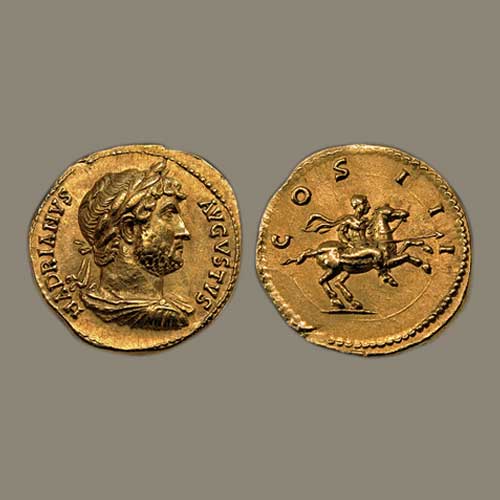Ancient Roman Coins, Depicting Roman Emperor Hadrian
2017-12-20 Wed
During the peak of Roman prosperity, Hadrian was the third of the five good emperors. However, his ascension was somewhat undecided since his predecessor Trajan had not chosen a successor until he was on his deathbed. Trajan’s wife Plotina sent a letter to the Senate, declaring Hadrian as the new heir, and only after the appointment was confirmed did she inform the Senate that Trajan had in fact already died, leading some to believe that Plotina took it upon herself to make Hadrian emperor.It doesn’t matter under which circumstances he came to power as Hadrian had a very successful reign. He completed several famous building projects, rebuilding the Pantheon in Rome and constructing the Vallum Aelium (Hadrian’s Wall), which marked the northern border of Roman Britain.
He was a military man and in order to build the trust of his troops, he spent a good amount of time with them, wearing military attire and dining with his soldiers. He increased the vigilance of their training and improved the strength of Rome’s forces by personally working with the legions in the field.
He accomplished this through extensive travel, visiting nearly every province of the Empire while trusted members of his staff maintained Rome in his absence. He would inspect the troops and suggest corrections, as well as allocate funds for construction projects and improved infrastructure within each of the provinces.
After his health started deteriorating, Hadrian chose Lucius Aelius Caesar to succeed him.However, shortly before his ascension, Aelius died suddenly from what is believed to have been a brain hemorrhage. In his stead, Hadrian appointed Antoninus Pius with the provision that he would then choose Marcus Aurelius and Lucius Verus as his successors. Pius agreed, and the Golden Age of Rome continued.
Hadrian loved Greek art and his portrait on coins shows a noble profile in an idealized and attractive style. This coin depicts Hadrian wearing a full beard, a first for a Roman emperor. Hadrian was a follower of Stoic philosophy, and he adopted the Hellenistic fashion of philosophers and intellectuals by wearing a well-kept beard.
He was consistent in his bearded depiction on coins, departing from the precedent set by the Senate that Romans had to be shown clean-shaven. Hadrian’s main focus was on securing Rome’s borders and not on expanding the Empire, but he wanted to remind the public that he was equally capable of offensive strategies. Therefore, the reverse of this aureus was chosen to show the emperor as a successful military commander, conveying his strength by depicting him with a flying cape on horseback and hurling a lance.
The circle surrounding the emperor on the reverse is a “guideline”, used to properly align the dies. Its presence indicates a very early die state, making this one of the first coins struck with unworn dies. It is therefore fitting that it was featured as the representative example of the type in the Calico reference guide.
HADRIAN. 117-138 CE. AV Aureus (7.19 g, 6h). Struck 124-128 CE. Laureate head right, slight drapery at shoulder / Hadrian on horseback right, holding lance. RIC II 187e; UCR 350. C414. Calico 1226 (this coin) Struck on a broad flan. Lustrous and Bold EF. Ex. Aloysius Lynn Collection, Ex. Freeman & Sear MBS 7, Feb 2002, lot 470.
Latest News
-
Janma Kalnayak of Bhagwan Mahavir
2024-04-24 WedOn 21st April 2024 which was the 2550th Janma Kalnyanak of Bhagwan Mahavir Swami, PM Modi unveile...
-
Gold Pagoda of Vijaynagar Empire King Deva Raya I
2024-04-10 WedKing Deva Raya I of the Vijayanagara Empire was a patron of Kannada literature and architecture. He ...
-
Silver Denarius of Septimus Severus
2024-04-05 FriLucius Septimius Severus served as the Roman emperor from 193 to 211 AD. Severus sat on the throne o...
-
Extremely rare 'Malaharamari' type Gold Gadyana of King Guhalladeva-III Sold for INR 611000
2024-04-03 WedTribhuvanamalla, also known as Guhalladeva III, was the ruler of the Kadamba dynasty. His reign coin...
-
90 Years of RBI
2024-04-02 TueOn 1st April, PM #Modi unveiled a special commemorative coin marking 90 Years since the foundation o...

